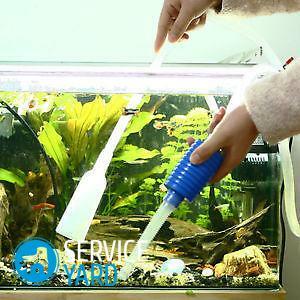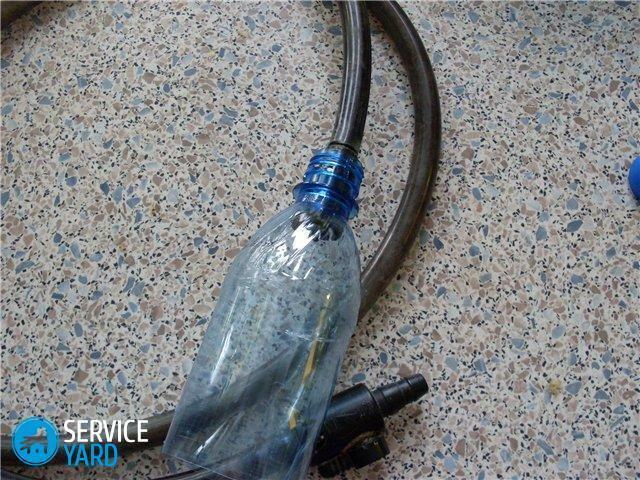
- Why clean the aquarium soil?
- How to clean the aquarium with a siphon?
- Professional devices for cleaning the aquarium bottom
- Important details when buying an aquarium siphon
- How to make a siphon with your own hands and clean up the aquarium soil?
- Useful recommendations for making a siphon with your own hands and storing it:
The aquarium requires constant care, which includes not only filtering, topping up or changing water, but also cleaning the soil. A special device that manages this task can be bought in any animal, but you can also make a siphon for the aquarium with your own hands. Information on how to embody the idea in reality, you will find in this article.
to the contents ↑Why clean the aquarium soil?
Fish in the process of their life leave a variety of debris. Often the owner overfeeds his pets, and the fish simply do not have time to eat food. The remains of vegetation, as well as excrement - all this clogs the aquarium, settles on its bottom and mixes with the substrate. Therefore, in the house of fish should be regularly cleaned.
Important! Timely cleaning of the aquarium substrate prevents the soil from souring and the formation of ammonia and hydrogen sulphide dangerous for underwater inhabitants.
The frequency of the procedure depends on the number of residents of the glass house:
- Some aquarists clean the soil in a reservoir of water weekly.
- Others - perform a spring cleaning twice or even once a month.
Important! To help make high-quality cleaning of the substrate, special devices can be used, one of which is a siphon.
Earlier, when there were no siphons, the entire soil had to be removed from the aquarium and washed, and then placed again on the bottom of the vessel. However, it was noted that such a procedure has a negative effect on the creation of a microflora-friendly water for underwater inhabitants. Useful bacteria died, and pathogens developed rapidly. With the advent of siphons for cleaning aquarium soil, this problem has disappeared.
to the contents ↑How to clean the aquarium with a siphon?
What is a siphon for an aquarium and how can it clean the fish house? In simple words, this device is an ordinary pump. The main part of the siphon is a suction pipe, which pumps out dirt and waste together with water.
Principle of operation of the
The siphon operates according to a fairly simple principle:
- The end of the tube or hose comes close to the aquarium soil.
- The other end should be on the outside of the fish tank, at a level well below the bottom of the aquarium above some capacity.
- To start the operation of an aquarium vacuum cleaner, it only remains to create a vacuum in the tube, which is, as a matter of fact, simply a simple intake of air by the mouth.
- Water with garbage will begin to merge into the tank. In order to weed out waste, it is necessary to defend water. The cleaned liquid can be returned to the aquarium and the dirt removed.
Professional devices for cleaning the aquarium bottom
An assortment of these devices can please with its variety, both in functionality and price. From such an abundance even an experienced aquarist can get lost before buying. In order not to get into a mess and choose a good and necessary model, we will get acquainted with the main types and useful constructive details of professional siphons.
There are two types of cleaning equipment for aquarium soil:
- Electric - devices that operate from the mains or autonomously with the help of batteries. Such devices can supply water even if the outlet pipe is located above the water level in the aquarium. If the outlet is located far from the fish nursery, it will be more convenient to use a battery-powered device.
- Mechanical - devices that do not have an electric drive. For a more convenient start-up of the siphon, manufacturers began to produce models with a pear-shaped pump. With its help, the risk of swallowing dirty aquarium water while pumping air from the system is reduced to zero.
Popular brands of
The leading manufacturers of such aquarium equipment are the following brands:
- EHEIM( Germany);
- HAGEN( Germany);
- AQUAEL( Poland);
- Tetra.
Important details when buying an aquarium siphon
There are some technical features of such devices that must be considered when choosing the right device for you.
Height and width of the socket
Choose this option, based on ease of use in your aquarium:
- For tall tanks, appliances with a long bell and wide mouth are more suitable.
- In small tanks, it will be extremely inconvenient to operate such a siphon.
Important! Siphonitis should be only those areas of the bottom where there is no vegetation.

Diameter and length of hose
Productivity of the device depends on these parameters. If the sink is too low relative to the bottom of the tank and the hose is too thick, the intensity of the pressure will lead to the dragging into the funnel of not only debris from the ground, but also its particles.
Important! Select the device depending on the density of the soil:
- For light soils, it is better to choose a device with a weak head.
- For heavy - vice versa, with a powerful.
Tap on the siphon drain
This part makes the operation of the device more convenient. It allows to regulate the intensity of the water flow passing through the device. Without such a tap, it is very inconvenient to siphonize the ground, because you have to constantly change the height of the sink or pinch it with your finger.
Mesh in the fence
Such a detail prevents the tightening in the device of pebbles from the ground or small inhabitants of the aquarium.
Filter on the siphon of the siphon
Some machines are equipped with a special small-sized bag of small cloth that is on the siphon drain. Thanks to it, the water that is drained into the tank is already cleaned of debris, and it can be reused immediately, that is, poured into the aquarium without further sedimentation.
Important! In the event that cleaning the aquarium for a long time has not been done, then the pumped water should not be used again, even if there is a filter on the siphon. Ammonium salts and nitrites, which are abundant in liquid, will cause the death of all living organisms in the reservoir.
to the contents ↑How to make a siphon with your own hands and clean up the aquarium soil?
It is not so difficult to make such a device independently. And clean the bottom of the tank with water and so much easier.
Procedure:
- First you need to select the right hose for your aquarium.
Important! For a tank with a volume of 100 liters, a tube with a diameter of 10 mm is suitable. Based on these parameters, you can calculate the required hose diameter for your aquarium.
- Cut a plastic bottle in half.
- Attach the neck to the edge of the hose.
- Lower the hose into the aquarium so that the cut of the plastic bottle touches the ground.
- Lower the other end of the hose into the tank, which is below the position of the aquarium.
- Create a thrust with your mouth and begin to siphonize the soil by moving the neck of the bottle over it.
Important! Select the distance from the surface of the ground to the funnel so that as little as possible of the substrate itself is absorbed into the siphon. If this happens, raise the bell higher. Thus, the traction from the surface of the ground will decrease, and the substratum trapped in the siphon will fall out.
- After completion of the cleaning, allow the water to settle for half an hour.
- Strain the standing water and pour back into the aquarium.
Useful tips for making a siphon with your own hands and storing it:
- The hose should have an internal diameter of 0.8 to 1.2 cm. The main thing is that it should not be larger than the diameter of the smallest pebble in the aquarium.
- It is better that the hose is transparent. Thus, you will notice the blockage in time if it occurs.
- It should be noted that corrugated, reinforced and other reinforced structures for this type of hose are not at all suitable. The best version of the material will be polyvinyl chloride, which is compact, elastic and light.
- Store the hose in a folded form without any creases. Otherwise, cracks can form in places of kinks.
Now, knowing what a siphon is and how to clean it, your aquarium will become even more beautiful, and the fish are more healthy. Buy the device is not difficult, but also just make a siphon for the aquarium with your own hands. Here, the choice will depend only on the financial capabilities, desire and convenience of the aquarist.
